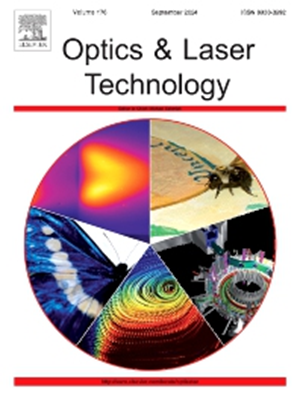Surface morphology and properties of structural steel via laser cleaning with saline solution pretreatment
IF 4.6
2区 物理与天体物理
Q1 OPTICS
引用次数: 0
Abstract
As a novel green cleaning technology, laser cleaning has garnered significant attention. However, its efficacy may be limited for steel structures with deep rust layers formed under prolonged natural environmental exposure. To address this challenge, this study systematically compares the performance of dry laser cleaning, wet laser cleaning and saline solution-laser composite cleaning for rust removal on Q235 structural steel, focusing on surface morphology, roughness, hardness, and microstructural evolution. Results demonstrate that acidic saline solution-laser composite cleaning achieves optimal performance at a pulse frequency of 80 kHz, a laser power of 80 W and 8 cleaning passes, characterized by minimal residual contaminants (Sa = 3.266 µm, Sq = 5.316 µm), uniform surface profiles, and the highest hardness value (192.14 HV). Mechanistic analysis reveals that the acidic solution dissolves rust layers via acidic reactions while generating cracks/pores to enhance laser energy absorption. Subsequent laser irradiation induces localized high temperatures and pressures, vaporizing residual rust and suppressing secondary oxidation through a retained liquid film. In contrast, alkaline cleaning primarily removes oily contaminants via alkaline saponification but exhibits limited rust dissolution due to insufficient Fe3+ activation. Dry laser cleaning underperforms due to oxide retention and roughness inhomogeneity. This study proposes a scalable and adaptive rust removal strategy, highlighting the industrial potential of saline solution-laser synergy in complex corrosion scenarios.
盐水溶液激光清洗对结构钢表面形貌及性能的影响
激光清洗作为一种新型的绿色清洁技术,受到了广泛的关注。然而,对于长期暴露在自然环境下形成深锈层的钢结构,其效果可能受到限制。为了解决这一挑战,本研究系统地比较了干式激光清洗、湿式激光清洗和盐水溶液-激光复合清洗对Q235结构钢除锈的性能,重点研究了表面形貌、粗糙度、硬度和显微组织演变。结果表明,在脉冲频率为80 kHz、激光功率为80 W、清洗次数为8次的条件下,酸性盐水溶液-激光复合清洗效果最佳,清洗过程中残留杂质最少(Sa = 3.266µm, Sq = 5.316µm),表面轮廓均匀,硬度最高(192.14 HV)。机理分析表明,酸性溶液通过酸性反应溶解锈层,同时产生裂纹/孔隙,增强激光能量吸收。随后的激光照射诱导局部高温和高压,汽化残留的铁锈,并通过保留的液体膜抑制二次氧化。相比之下,碱性清洗主要通过碱性皂化去除油性污染物,但由于Fe3+激活不足,导致铁锈溶解有限。干式激光清洗由于氧化物保留和粗糙度不均匀性而表现不佳。本研究提出了一种可扩展和自适应的除锈策略,强调了盐溶液-激光协同在复杂腐蚀场景中的工业潜力。
本文章由计算机程序翻译,如有差异,请以英文原文为准。
求助全文
约1分钟内获得全文
求助全文
来源期刊
CiteScore
8.50
自引率
10.00%
发文量
1060
审稿时长
3.4 months
期刊介绍:
Optics & Laser Technology aims to provide a vehicle for the publication of a broad range of high quality research and review papers in those fields of scientific and engineering research appertaining to the development and application of the technology of optics and lasers. Papers describing original work in these areas are submitted to rigorous refereeing prior to acceptance for publication.
The scope of Optics & Laser Technology encompasses, but is not restricted to, the following areas:
•development in all types of lasers
•developments in optoelectronic devices and photonics
•developments in new photonics and optical concepts
•developments in conventional optics, optical instruments and components
•techniques of optical metrology, including interferometry and optical fibre sensors
•LIDAR and other non-contact optical measurement techniques, including optical methods in heat and fluid flow
•applications of lasers to materials processing, optical NDT display (including holography) and optical communication
•research and development in the field of laser safety including studies of hazards resulting from the applications of lasers (laser safety, hazards of laser fume)
•developments in optical computing and optical information processing
•developments in new optical materials
•developments in new optical characterization methods and techniques
•developments in quantum optics
•developments in light assisted micro and nanofabrication methods and techniques
•developments in nanophotonics and biophotonics
•developments in imaging processing and systems

 求助内容:
求助内容: 应助结果提醒方式:
应助结果提醒方式:


